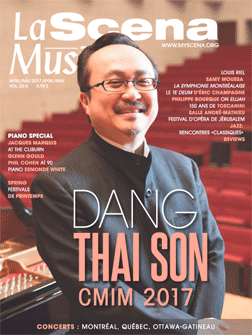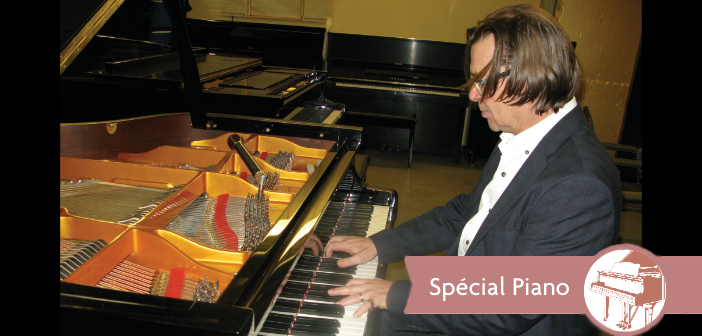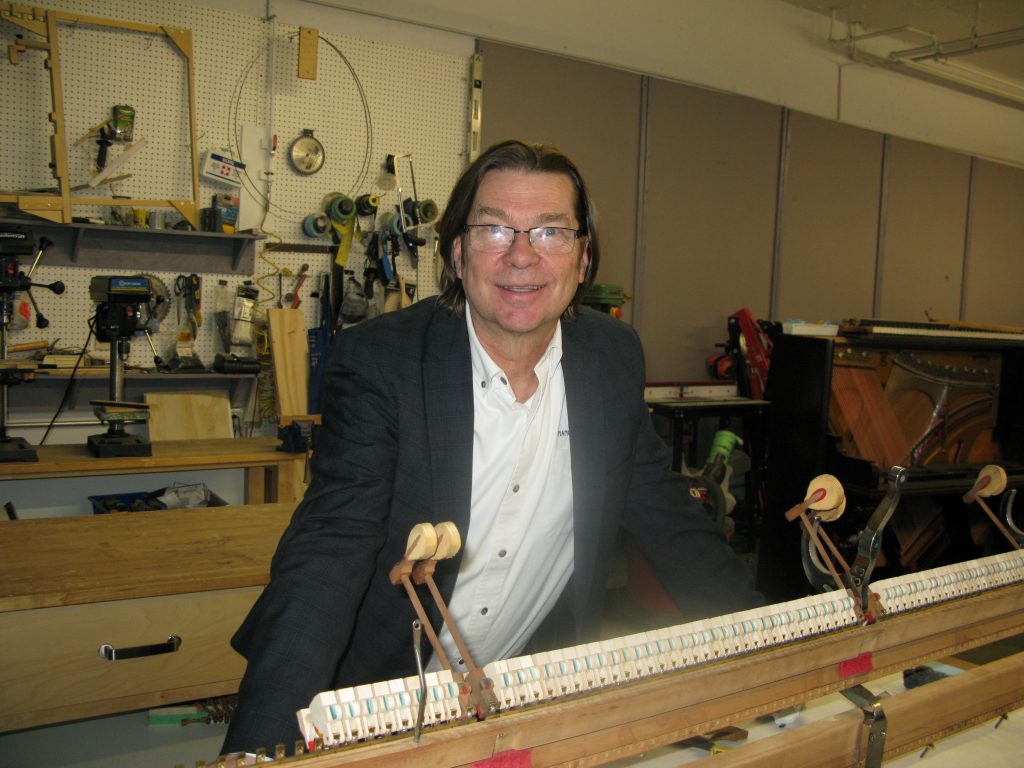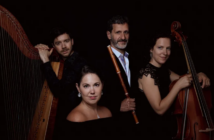
Oliver Esmonde-White’s great passion is the piano. But his love for the instrument is different from that of the pianist, whose heroes may be Bach, Beethoven or other great composers. Esmonde-White, a master piano technician, draws inspiration from the great piano builders of the past.
“Pianos were glorious once upon a time,” he said, citing names like Bechstein, Mason & Hamelin and Bösendorfer. Each piano had a distinct sound, but was considered on par with Steinway. Closer to home, “We have forgotten that Heintzman, Willis, Lesage and Lindsay were made not far from here. We have done virtually no research and development on pianos in the last 100 years.”
Though piano manufacturing was a thriving industry in Canada from 1890 until well into the 20th century, it gradually came to a standstill for a number of reasons, including the Great Depression, radios and record players, a decreased demand for pianos from music schools, mass production, and the importation of inexpensive pianos from China.
But surrounded by gleaming grands and uprights in his showroom on avenue de Gaspé, most of which bear his name, Esmonde-White talks about his dream. “I want to turn the piano industry on its head. We are in a technological era and there is so much we can do.”
Starting his own line of handmade pianos was not what Esmonde-White originally set out to accomplish. Having been the first North American piano technician to attend the prestigious Yamaha Piano Technical Academy, and serving as a consultant for the same company, his insatiable curiosity drove him to understand how the piano worked. When two Université de Montréal piano professors asked him to explain why pressing down on their piano keys felt better after Esmonde-White had worked on the action, he realized he himself didn’t know. “It took me a few years to get my head into it, I had to go back to 1800s to study the Érard evolution of piano mechanism in modern pianos.” Sébastien Érard, born in 1752, invented the double escapement mechanism that allows the same keys to be depressed repeatedly, an innovation still used in modern pianos.
Esmonde-White was obsessed with finding the answer, and in time had an “Aha moment.” “A lightbulb went off and I saw the center pins, like stars, geometric patterns, how they were moving, and all of a sudden I had an understanding of the [sensation]and how to control it.”
The answer lay in what Esmonde-White calls synchronicity. He explains that the term “double escapement” is a misnomer of what is actually “two distinct and interacting mechanisms” moving in synchrony. When the parts are not in sync, the touch is affected.
It was after giving a seminar on this subject, which he modestly considers his “minor claim to fame,” that he met his mentor and friend Darrell Fandrich, an innovative piano manufacturer who invented several piano actions. Trained as a piano tuner and technician, Fandrich obtained his degree in engineering. He and his research partner John Rhodes created a computer software, the Fandrich Rhodes Weight Bench™ Touchweight System, that guides the technician regulating the action to produce a smoother, more even response from the piano.
“They gave us the equivalent of a GPS for piano actions,” Esmonde-White said. “You know where you want to go and it gives you the route how to get there.”
Fandrich also invented the Fandrich Vertical Action™ that, when installed in an upright piano, causes it to respond like a grand.
Esmonde-White began working with Fandrich 10 years ago, wanting “to be his disciple” and later representing Fandrich and Sons pianos in Montreal. These used pianos were bought whole, disassembled, rebuilt with quality parts, and retrofitted with the vertical action. The result was an affordable instrument with a much higher quality than the original.
For economic reasons, it made more sense for Esmonde-White to continue making the pianos on his own, which he did with Fandrich’s blessing. His upright pianos contain Fandrich’s Vertical Action and for the grands, he also uses Fandrich’s technology. “Darrell gave me the tools. His work makes it possible for the work I do to turn out right.”
He shares Fandrich’s values in making quality pianos accessible. “My interest is to take a piano with a decent structure but that doesn’t sound right, find out what is wrong, and improve it. The goal was not to compete with Steinway but to make an affordable piano for musicians. If I can emulate Fandrich and bring out a really decent piano at a decent price, I am doing a service to my community.”
The first Esmonde White piano introduced in 2016 was a 6-foot grand. Currently there are four upright and three grand models available. The pianos have been well received, and one was used in the TV program Crescendo, to Esmonde-White’s surprise. “Almost all our pianos have been sold to musicians. We haven’t had anything but praise,” he said.
A lot of breakthroughs are happening in the industry, Esmonde-White says. “Knowledge was lost with mass manufacturing. We killed our industry but now it’s ready to be reborn. All things are cyclical and now a new cycle is about to begin. I like to think of myself as being in tune with that cycle.”
Working as a piano technician means lifelong learning, he says. “There is no such thing as the best piano technician. We have some really talented people in Quebec. You start off as a technician, you turn into an artisan, then an artist. If you are lucky, you add scientist to the mix.”
Piano Esmonde White, www.pianoew.com

















